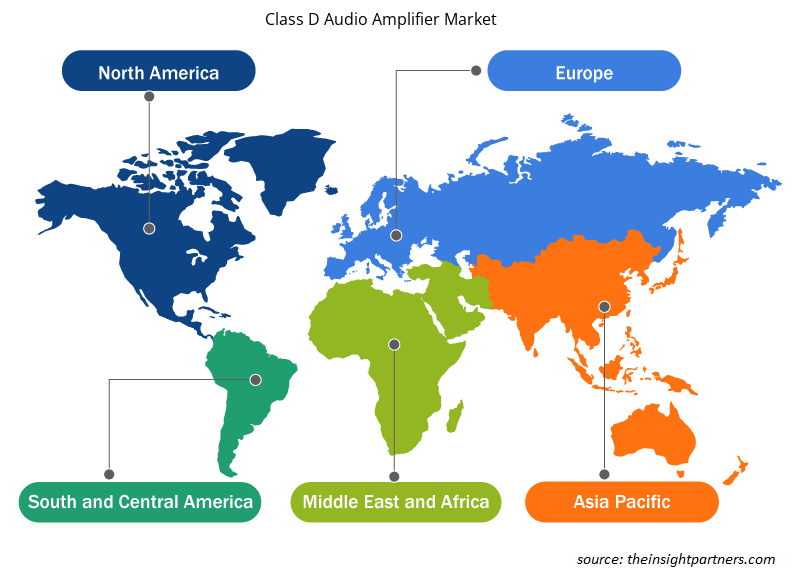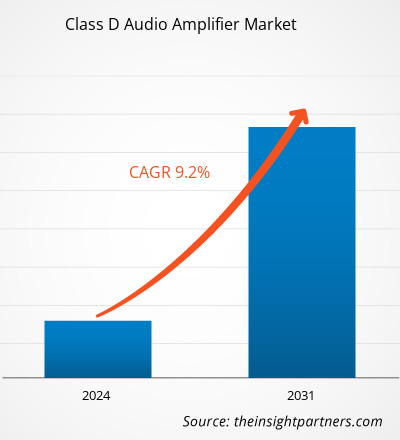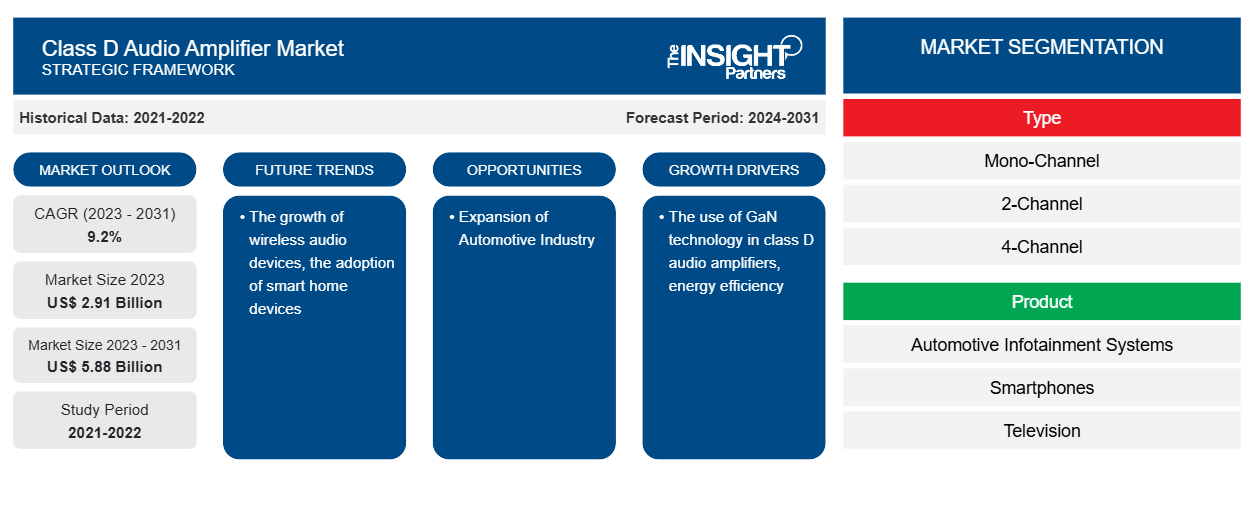Der Markt für Audioverstärker der Klasse D soll von 2,91 Milliarden US-Dollar im Jahr 2023 auf 5,88 Milliarden US-Dollar im Jahr 2031 anwachsen. Der Markt wird zwischen 2023 und 2031 voraussichtlich eine durchschnittliche jährliche Wachstumsrate von 9,2 % verzeichnen. Das Wachstum bei drahtlosen Audiogeräten und die Einführung von Smart-Home-Geräten dürften weiterhin ein wichtiger Trend auf dem Markt bleiben.
Marktanalyse für Audioverstärker der Klasse D
Im Wesentlichen ist ein Audioverstärker der Klasse D ein Schaltverstärker, der manchmal auch als PWM-Verstärker bezeichnet wird. Große öffentliche Durchsagen, Sprachverstärkung und Live-Sound-Systeme verwenden zunehmend die Technologie der Klasse D anstelle der traditionell umständlichen, schweren und ineffizienten Leistungsverstärker. Verstärker der Klasse D können auch gut für Bluetooth -Kopfhörer geeignet sein, während aufgrund des relativ geringen Lautstärkebedarfs auch andere Verstärkertypen in diesem speziellen Szenario verwendet werden können. Verstärker der Klasse D sind auch in einer Vielzahl anderer Produkte zu finden, beispielsweise in Stereoverstärkern und tragbaren Kopfhörerverstärkern.
Marktübersicht für Audioverstärker der Klasse D
Die Hauptfaktoren, die die Nachfrage nach Audioverstärkern der Klasse D antreiben, sind unter anderem der zunehmende Einsatz in elektronischen Geräten der Unterhaltungselektronik wie Lautsprechern, Bluetooth-Audiogeräten und Heimkinos. Die steigende Nachfrage nach Infotainmentsystemen für Autos treibt die Marktnachfrage weltweit ebenfalls an.
Passen Sie diesen Bericht Ihren Anforderungen an
Sie erhalten kostenlose Anpassungen an jedem Bericht, einschließlich Teilen dieses Berichts oder einer Analyse auf Länderebene, eines Excel-Datenpakets sowie tolle Angebote und Rabatte für Start-ups und Universitäten.
-
Holen Sie sich die wichtigsten Markttrends aus diesem Bericht.Dieses KOSTENLOSE Beispiel umfasst eine Datenanalyse von Markttrends bis hin zu Schätzungen und Prognosen.
Markttreiber und Chancen für Audioverstärker der Klasse D
Einsatz der GaN-Technologie in Audioverstärkern der Klasse D soll den Markt begünstigen
Silizium-MOSFETs wurden als De-facto-Transistortechnologie bei der Entwicklung von Class-D-Verstärkern verwendet. Die GaN-Technologie ermöglicht nun die Entwicklung einer neuen Verstärkergeneration, die zu erheblichen Verbesserungen bei Produktleistung und Audioqualität führen wird. Die schnelle Schaltgeschwindigkeit von Silizium-MOSFETs begrenzt die Audioleistungsoptionen, die den Entwicklern zur Verfügung stehen. GaN-Transistoren haben eine wesentlich höhere Betriebsfrequenz und ermöglichen dadurch sanfte, schnelle Schaltübergänge. Daher umfassen GaN-Class-D-Audiosysteme kleinere, effektivere Audiogeräte mit deutlich besserer Audioleistung. Die Anwendung der GaN-Technologie im Class-D-Audiodesign wird es den Entwicklern ermöglichen, eine neue Welle innovativer Produkte mit verbesserter Energieeinsparung und besserer Audioleistung in neuen, kleineren Formfaktoren zu kostengünstigen Preisen herzustellen.MOSFET has been used as the de facto transistor device technology in the creation of Class-D amplifiers. GaN technology now makes it feasible to design a new generation of amplifiers that will lead to significant advancements in product performance and audio quality. Silicon MOSFETs' fast switching limits the audio performance options available to designers. GaN transistors have a substantially higher operating frequency, enabling smooth, quick switching transitions. As a result, GaN Class-D audio systems include smaller, more effective audio devices with noticeably better audio performance. The application of GaN technology in Class-D audio design will make it possible for designers to produce a new wave of inventive products with enhanced energy economy and better audio performance in new, smaller form factors at cost-effective pricing.
Expansion der Automobilindustrie
Die globale Automobilindustrie ist auf dem Vormarsch. Mit der zunehmenden Vorliebe für hochmoderne Unterhaltungszentren im Auto steigt die Nachfrage nach Audioverstärkern der Klasse D. Mit der Integration von Unterhaltungs-, Navigations-, Kommunikations- und Fahrzeugsteuerungssystemen in nahtlose Benutzererlebnisse bilden Automobil und Infotainment einen entscheidenden Zusammenfluss von Technologien in modernen Automobilen. Durch eine Vielzahl an Bordelektronik und Apps bietet Automotive Infotainment, auch bekannt als In-Vehicle Infotainment (IVI), Fahrern und Passagieren Unterhaltung und Informationen. Es ist eine Integration von Hardware und Software. Audioverstärker der Klasse D bilden einen wichtigen Teil der Audiosysteme im Auto. Somit schafft die zunehmende Vorliebe für verbesserte Infotainmentsysteme Möglichkeiten für das Wachstum des Marktes für Audioverstärker der Klasse D.IVI), provides drivers and passengers with entertainment and information. It is an integration of hardware and software. Class D audio amplifiers form a major part of the audio systems in the car. Thus, the rising preference for enhanced infotainment systems is creating opportunities for the growth of the Class D audio amplifier market.
Marktbericht zu Audioverstärkern der Klasse D – Segmentierungsanalyse
Wichtige Segmente, die zur Ableitung der Marktanalyse für Audioverstärker der Klasse D beigetragen haben, sind Typ, Produkt und Branche.
- Basierend auf dem Typ ist der Markt für Audioverstärker der Klasse D in Monokanal, 2-Kanal, 4-Kanal und 6-Kanal unterteilt. Das Monokanalsegment hatte im Jahr 2023 den größten Anteil.
- Basierend auf dem Produkt ist der Markt in Auto-Infotainmentsysteme, Smartphones, Fernseher und Sonstiges unterteilt.
- Basierend auf der Branchenvertikale ist der Markt in Automobil, Unterhaltungselektronik und Sonstige unterteilt.
Marktanteilsanalyse für Audioverstärker der Klasse D nach geografischer Lage
Der geografische Umfang des Marktberichts für Audioverstärker der Klasse D ist hauptsächlich in fünf Regionen unterteilt: Nordamerika, Asien-Pazifik, Europa, Naher Osten und Afrika sowie Süd- und Mittelamerika.
Nordamerika hält im Jahr 2023 einen bedeutenden Anteil am Markt für Audioverstärker der Klasse D. Nordamerika ist einer der größten Märkte für Unterhaltungselektronik und auch ein bedeutender Automobilhersteller. Länder wie die USA sind die Heimat der weltweit größten Hersteller von Unterhaltungselektronik und treiben so das Wachstum der Region voran.
Regionale Einblicke in den Markt für Audioverstärker der Klasse D
Die regionalen Trends und Faktoren, die den Markt für Audioverstärker der Klasse D im gesamten Prognosezeitraum beeinflussen, wurden von den Analysten von Insight Partners ausführlich erläutert. In diesem Abschnitt werden auch die Marktsegmente und die Geografie der Audioverstärker der Klasse D in Nordamerika, Europa, im asiatisch-pazifischen Raum, im Nahen Osten und Afrika sowie in Süd- und Mittelamerika erörtert.

- Erhalten Sie regionale Daten zum Markt für Audioverstärker der Klasse D
Marktbericht zu Audioverstärkern der Klasse D – Umfang
| Berichtsattribut | Details |
|---|---|
| Marktgröße im Jahr 2023 | 2,91 Milliarden US-Dollar |
| Marktgröße bis 2031 | 5,88 Milliarden US-Dollar |
| Globale CAGR (2023 - 2031) | 9,2 % |
| Historische Daten | 2021-2022 |
| Prognosezeitraum | 2024–2031 |
| Abgedeckte Segmente |
Nach Typ
|
| Abgedeckte Regionen und Länder |
Nordamerika
|
| Marktführer und wichtige Unternehmensprofile |
|
Marktteilnehmerdichte für Audioverstärker der Klasse D: Auswirkungen auf die Geschäftsdynamik verstehen
Der Markt für Audioverstärker der Klasse D wächst rasant, angetrieben durch die steigende Nachfrage der Endnutzer aufgrund von Faktoren wie sich entwickelnden Verbraucherpräferenzen, technologischen Fortschritten und einem größeren Bewusstsein für die Vorteile des Produkts. Mit steigender Nachfrage erweitern Unternehmen ihr Angebot, entwickeln Innovationen, um die Bedürfnisse der Verbraucher zu erfüllen, und nutzen neue Trends, was das Marktwachstum weiter ankurbelt.
Die Marktteilnehmerdichte bezieht sich auf die Verteilung der Firmen oder Unternehmen, die in einem bestimmten Markt oder einer bestimmten Branche tätig sind. Sie gibt an, wie viele Wettbewerber (Marktteilnehmer) in einem bestimmten Marktraum im Verhältnis zu seiner Größe oder seinem gesamten Marktwert präsent sind.
Die wichtigsten Unternehmen auf dem Markt für Audioverstärker der Klasse D sind:
- Analog Devices, Inc
- INFINEON TECHNOLOGIES AG
- NXP-Halbleiter.
- ON Semiconductor Corporation
- Qualcomm Technologies, Inc.
- STMicroelectronics NV
Haftungsausschluss : Die oben aufgeführten Unternehmen sind nicht in einer bestimmten Reihenfolge aufgeführt.

- Überblick über die wichtigsten Akteure auf dem Markt für Audioverstärker der Klasse D
Neuigkeiten und aktuelle Entwicklungen zum Markt für Audioverstärker der Klasse D
Der Markt für Audioverstärker der Klasse D wird durch die Erhebung qualitativer und quantitativer Daten nach Primär- und Sekundärforschung bewertet, die wichtige Unternehmensveröffentlichungen, Verbandsdaten und Datenbanken umfasst. Nachfolgend sind einige der Entwicklungen auf dem Markt für Audioverstärker der Klasse D aufgeführt:
- Die Infineon Technologies AG hat kürzlich ihre neueste Generation von MERUS™ Multilevel-Audioverstärkern der Klasse D vorgestellt. Mehrere Ökosystempartner von Infineon sind nun bereit, interessierte Kunden bei ihren Design-In-Bemühungen zu unterstützen. Durch die Partnerschaft mit den Experten will das Unternehmen die Einführung neuer und innovativer Technologien vorantreiben. Die Audioverstärker der Klasse D von Infineon ermöglichen eine Hi-Fi-Klangwiedergabe mit einer einzigartigen Klasse-D-Modulation von bis zu 5 verschiedenen Ausgangsspannungspegeln. (Quelle: Infineon Technologies, Pressemitteilung, Januar 2023)
Marktbericht zu Audioverstärkern der Klasse D – Abdeckung und Ergebnisse
Der Bericht „Marktgröße und Prognose für Audioverstärker der Klasse D (2021–2031)“ bietet eine detaillierte Analyse des Marktes, die die folgenden Bereiche abdeckt:
- Marktgröße und Prognose für Audioverstärker der Klasse D auf globaler, regionaler und Länderebene für alle wichtigen Marktsegmente, die im Rahmen des Berichts abgedeckt sind
- Markttrends für Audioverstärker der Klasse D sowie Marktdynamik wie Treiber, Einschränkungen und wichtige Chancen
- Detaillierte PEST/Porters Five Forces- und SWOT-Analyse
- Marktanalyse für Audioverstärker der Klasse D mit wichtigen Markttrends, globalen und regionalen Rahmenbedingungen, wichtigen Akteuren, Vorschriften und aktuellen Marktentwicklungen
- Branchenlandschaft und Wettbewerbsanalyse, einschließlich Marktkonzentration, Heatmap-Analyse, prominenten Akteuren und aktuellen Entwicklungen auf dem Markt für Audioverstärker der Klasse D.
- Detaillierte Firmenprofile
- Historische Analyse (2 Jahre), Basisjahr, Prognose (7 Jahre) mit CAGR
- PEST- und SWOT-Analyse
- Marktgröße Wert/Volumen – Global, Regional, Land
- Branchen- und Wettbewerbslandschaft
- Excel-Datensatz
Aktuelle Berichte
Verwandte Berichte
Erfahrungsberichte
Grund zum Kauf
- Fundierte Entscheidungsfindung
- Marktdynamik verstehen
- Wettbewerbsanalyse
- Kundeneinblicke
- Marktprognosen
- Risikominimierung
- Strategische Planung
- Investitionsbegründung
- Identifizierung neuer Märkte
- Verbesserung von Marketingstrategien
- Steigerung der Betriebseffizienz
- Anpassung an regulatorische Trends























 Kostenlose Probe anfordern für - Markt für Audioverstärker der Klasse D
Kostenlose Probe anfordern für - Markt für Audioverstärker der Klasse D